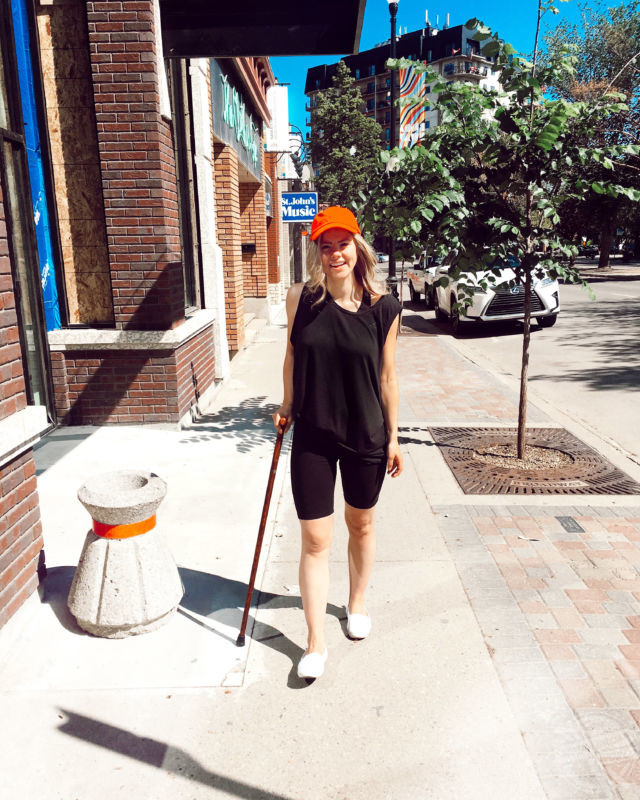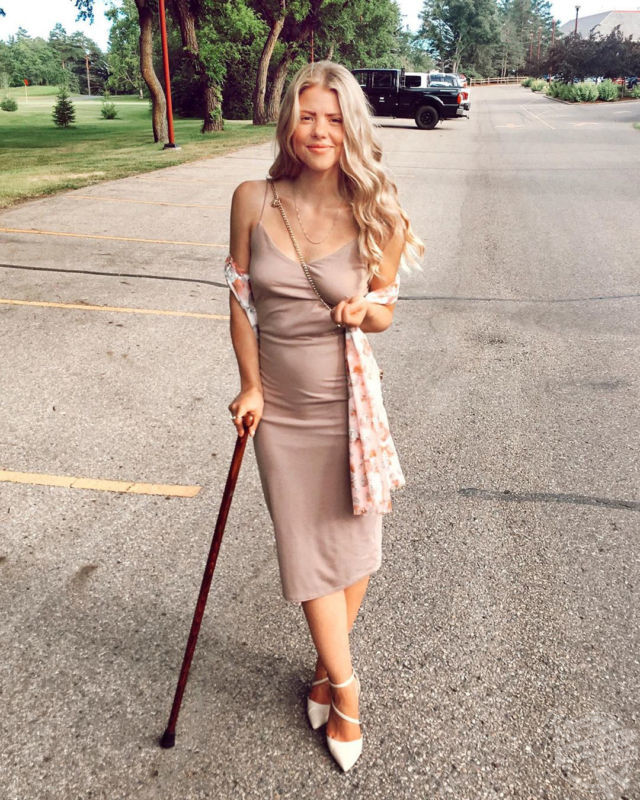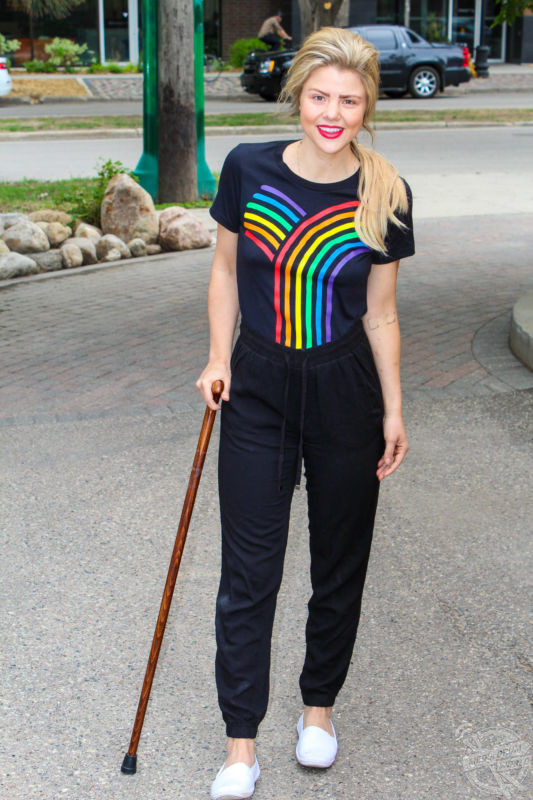By Alyce Collins
THIS WOMAN heard her spine POP during a YOGA CLASS as one of the bones in her spine BROKE and caused her years of chronic pain, which left her unable to WALK, until a spinal fusion was her last resort at having any chance of regaining mobility.
Event planner, Jennifer Pond (31) from Saskatoon, Canada, was performing a sophisticated revolved hand to big toe yoga pose in 2014 when she heard a popping sound in her back. In the days that followed, she felt pain in her right leg and in her hip, but she just assumed it was a pulled muscle.
As the weeks passed, the pain spread to her left leg and lower back, making Jennifer realise it couldn’t just be a pulled muscle, so she made an appointment to see her doctor. An X-ray revealed that while doing yoga, Jennifer broke her interarticularis bone, a small bone found in the lower region of the spine. The pars interarticularis is connected to the facet joints in the spine, which help maintain spinal stability.

The injury compromised Jennifer’s facet joints and vertebras, causing the lower spine to slip forward, which is known as spondylolisthesis.
Since developing spondylolisthesis, Jennifer has lived with chronic pain, leg weakness, nerve pain, stiffness in her back and numbness in her legs and she tried many non-surgical treatments, including physiotherapy, acupuncture, spinal injections and massage therapy.
Despite trying to reduce her pain for four years, none of Jennifer’s efforts worked and she was left walking short distances with a limp and unable to complete the household duties or lift anything heavy because of the strain on her back. Jennifer’s life was brought to a standstill as she backed out of many career, family and social activities due to the pain.
A spinal fusion was Jennifer’s last option, and despite her fears of surgery and the 60 per cent chance the surgery would increase her quality of life, she knew she had run out of alternatives. Jennifer’s spinal fusion took place on June 10, 2019, and although recovery will be slow, she has already seen progress in her walking ability.
“I fractured my pars interarticularis bone during a yoga class,” said Jennifer.
“This bone is connected to your facet joints, which serve as train tracks for your spine, ensuring your vertebras don’t fall off track.
“I was in a standing twist pose when I heard an internal ‘pop’ in the lower region of my back. It wasn’t until later that I realised this small noise represented a moment that would change my life.
“Immediately after, I wasn’t aware that anything was severely wrong with my spine. My initial symptoms presented in my right leg with intense leg pain and painful sensations in my upper front hip.
“I assumed that I had merely pulled a leg muscle, however this theory could no longer be supported when the symptoms began presenting themselves in my left leg. By the time I made it to my doctor a few weeks later, the pain had made its way into my lower back. It took an X-ray to see what the problem was.
“The initial injury developed into a pretty severe condition called spondylolisthesis, meaning part of my lower spine is slipping forward. Specifically, one of my vertebras is slipping over the one below.
“As your spine is a complex part of all movement and surrounded by important anatomy, it’s a tough place for things to be shaking around.

“Since the injury, I’ve been in chronic pain. The pain changes and can move around my body but is always present in my lower back. Some of the other symptoms I have experienced include spontaneously falling, leg weakness, nerve pain, pain to the touch in my lower back, pain or stiffness in my upper back and shoulders, numbness and tingling in my feet, and at times numbness all the way up to my hips.
“My symptoms have varied over the years and the intensity can change on any given day – you have no real sense of what you’ll wake up to. Spondylolisthesis is like an ever-changing fingerprint: it’s not only unique to you but the print itself is constantly changing.
“I’ve worked very hard with my medical team and tried all conservative treatment methods, including physiotherapy, acupuncture, spinal injections, resting, icing and massage therapy. Unfortunately, there was no improvement and they would often cause inflammation.”
Jennifer hoped to avoid spinal surgery, but the years of non-surgical treatment came to no avail and surgery was her only option if she had any chance to get her life back.
The spinal fusion in June 2019 went well but the recovery continues to be a difficult journey, filled with highs and lows. After seeing some progression already, Jennifer is hopeful that her life can get back on track as she looks forward to building her career again, being active again and one day starting a family.
“As my condition worsened, so did my quality of life. I was unable to complete many normal and necessary life tasks. If I was physically able to do certain things, in most cases, I had to adjust how and how often I did the task,” said Jennifer.

“I have to schedule duties around the needs of my condition and most activities result in debilitating pain. There is a constant fear of further slippage.
“Although spinal fusion surgery has some scary short and long-term risks and there’s guaranteed outcomes, at this point, it was my only option left if I want to fight for stability both in my spine and life.
“I was very scared of surgery, but I was working with an incredible surgeon and I knew that my medical team had exhausted all other treatment options to avoid this surgery.
“My surgeon believed he could increase the quality of my life with the surgery, so that I have less pain and more stability. Surgery isn’t a cure, but it can help me regain my life back.
“My surgery was June 10 and waking up was traumatic. The pain was severe, and it took hours to get it under control. I was in the recovery room for roughly five hours and unfortunately stopped breathing twice so they had to massage my chest in order to resuscitate me.

“It is both a physical and mental battle, full of challenges that you must overcome. In the initial stages, the level of disability combined with the pain was overwhelming and at times unbearable, but what helps this situation is choosing to accept your position and allow your caregivers and family to take over.
“I also have to continually remind myself to sort of ride the recovery wave as each new day brings on different pain, emotions and obstacles.
“The recovery has been slow, but I am currently walking better. My left leg below my knee is mostly numb, but I’m staying positive.
“I want to build my life back up again and add those blocks back to it that I have lost over the years. I want to spend energy on finding my purpose and pursue that avenue. I look forward to having children one day that I will not only love, but I can physically hold and play with, and to be able to say yes to new opportunities that come my way!
“I would never be able to manage my way through these obstacles without the incredible support of my loved ones. Caregivers deserve so much acknowledgement for all they do in order to help those living with illness.”
To see more, visit www.instagram.com/jenn.pond






